Geology Reference
In-Depth Information
internal friction
f
), hillslope gradients (
b
),
relief, pore pressure, and seismic accelerations.
In a two-dimensional, steady-state, slope-
stability model (Culmann, 1875), and in the
absence of pore pressure or seismic shaking,
the maximum hillslope height (
H
c
) can be
expressed as
A
80 m
above
river
fluted
strath
surface
4sinc s
[1
c
βφ
(7.3)
H
=
c
γ
−
β
−
φ
cos(
)]
1-3 m of
relief on
strath
where
g
is the unit weight of the rocks of
the hillslope. Recent studies (Schmidt and
Montgomery, 1995) have shown that a hillslope's
failure characteristics are typically determined
by the strength of the weakest strata in a
hillslope, rather than by the mean rock strength
measured in a laboratory. Furthermore, the ori-
entation of beds or planes of weakness, such as
schistocity or foliation, exerts a strong control
on overall hillslope strength, because dip slopes
have a lower effective angle of internal friction
than do anti-dip slopes. Although this formula-
tion predicts the maximum hillslope height in a
landscape and suggests that, in an equilibrium
condition, there should be predictable limits to
local topographic relief, it does not predict a
rate of denudation by landsliding, because there
is no time dependence in the formulation.
Instead, it suggests that, under threshold condi-
tions, peaks will be lowered by landsliding at
the same rate that the valley bottoms are
lowered, such that this relief is maintained. If
the rate of valley lowering or river incision is
known, then, in this equilibrium landscape, the
time-integrated contribution of landsliding can
also be predicted. The rates themselves would
be dictated by the rates of valley incision, and
the hillslopes basically come along for the ride.
Another approach to quantifying denudation
by landsliding exploits a relationship between
Strath Terrace
B
2.5
8.2
Ma
4.7
Ma
I
ndus River
Straths
2.8
Ma
2.0
1.3
Ma
0.4
Ma
1.5
0.7
Ma
Dated strath
Cosmogenic age
Height above river
Apatite FT date
16 ka
155 m
1.0
1.1 Ma
W
est
East
C
10
incision rate
(strath terraces)
Incision Rate
(strath data)
7.5
5
NPHA
2.5
0
D
10
denudation rate
(apatite fission
track dates)
Deundation Rate
(apatite fission-
track data)
8
35
°
C/km
6
4
2
60
°
C/km
0
0
50
100
150
Distance (km)
Fig. 7.14
Bedrock incision along the
Indus River, Pakistan.
A. Annotated photograph of 80-m-high strath above
the Indus River near Haramosh, northern Pakistan.
B. Strath terraces with their cosmogenic nuclide
exposure ages and their heights above the modern river.
At river level, apatite fission-track ages are shown. Note
that the fission-track ages get progressively older toward
the Skardu Basin in the east. C. Incision rates (based on
strath ages) versus distance along the Indus. Note that
the highest rates are associated with the steepest
river gradient. D. Rates of denudation based on apatite
fission-track data. Two calculations are made, each with
a different geothermal gradient (35 and 60
°
C/km). Note
that the zone of maximum long-term denudation
coincides with the zone of most rapid river incision.
Modified after Burbank
et al.
(1996b).





































































































































